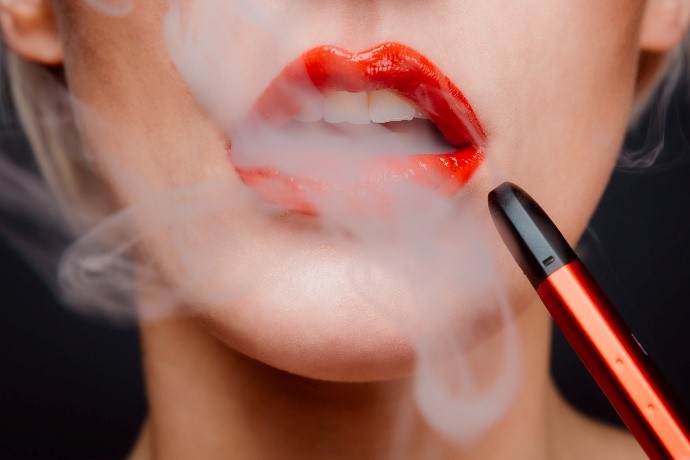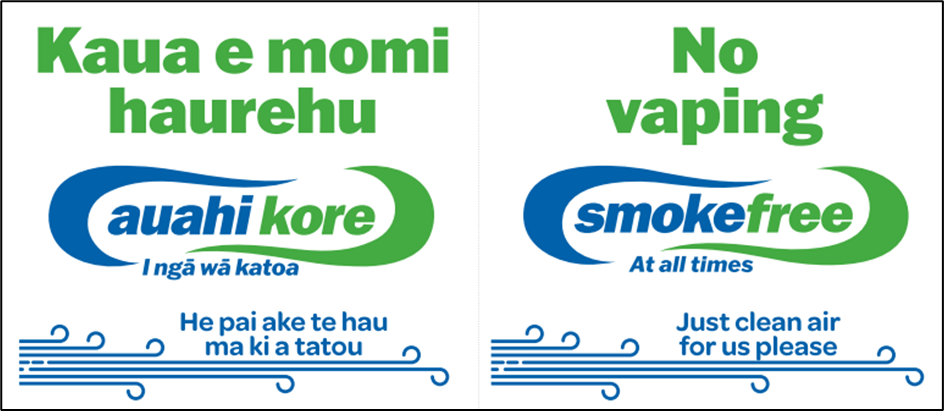Jenni Stephenson*
Aotearoa New Zealand has been a world leader in the smokefree arena and is doubling down on its efforts to reach the 2025 goal. This blog asks if is enough to aim just for smokefree or whether Te Tiriti o Waitangi demands we aim higher and eliminate vaping also.
Photo: Chiara Summer From: Unsplash
Under the Te Tiriti o Waitangi the Government is obliged to protect the health and wellbeing of Māori. It is further obligated under both the United Nations (UN) Declaration on the Rights of Indigenous Peoples (UNDRIP) and the WHO Framework Convention on Tobacco Control. But despite smoking rates falling since the adoption of the Smokefree 2025 target, disparities in smoking rates still exist with the largest gap evident for women aged 15 to 24 years. In the 2015/16 NZ Health Survey 34% of Māori in this group smoke compared with only 8% of non-Māori (1). It is further obliged under the UN Convention on the Rights of the Child (UNCROC) to ensure children are protected from the harms associated with smoking.
In recent years, the NZ Ministry of Health has adopted the position that vaping is useful for smokers who want to quit (2). It can be viewed as either a cessation tool, providing an effective replacement nicotine delivery system, or as a harm reduction tool. This position is backed by evidence that vaping is much less harmful than smoking burned tobacco and this evidence has been discussed at length by both proponents of vaping (3) and its opponents (4).
Big tobacco knows what it’s doing!
The big tobacco companies have a “history of factual misrepresentations, strategic use of misinformation, and the obfuscation of evidence in the interest of maintaining a strong customer base for a deadly product” (5)(p. 248). They are well versed in mass advertising that successfully recruits new smokers and have successfully applied the same tactics to its new products, electronic cigarettes. Vapes are glamourised in images that feature young people and present vaping in fashionable or on-trend settings. These images have been used to promote vaping in Aotearoa NZ (6) and specifically to target Māori (7) and other Indigenous peoples around the world (8, 9). There is also evidence that industry funding of research into the benefits of vaping for tobacco harm reduction has influenced study conclusions (10).
Photo: Elsa Olofsson From: Unsplash
KIDS EXPERIMENTING OR TOMORROW’S HEALTH INEQUITY?
Data from the 2018 Youth Insights Survey (11) show that the proportion of participants who have never tried smoking has increased to 84% for non-Māori and 61% for Māori. However, the result for vaping is less encouraging. Since the question was first asked in 2012, trying vaping has increased threefold, but the increase is most obvious for rangatahi Māori with an increase of 45% to 58% compared with a 25% increase for non-Māori to just 30%. These data suggest a startling trajectory if even a portion of these adolescent experimenters go on to develop a lifelong nicotine addiction. Analysis of the data by Walker et al (12) showed that while overall prevalence of vaping remains low, the rate of daily vaping has also increased and rangatahi Māori were 2.5 times more likely to use e-cigarettes daily.
It is estimated that as many as 1 in 4 first time tobacco smokers display the early signs of addiction (13) and while similar data for first time vapers is limited, the variety of toxic effects of vaping are also emerging with some studies suggesting nicotine addiction creates a pathway to addiction to other substances (4, 14, 15). Emerging research suggests the new generation of young vapers is already feeling trapped in the cycle of addiction; one study reports 62% of participants want to quit for good and 51% cite health concerns as their main worry (16). We in Aotearoa must therefore ask ourselves if we are happy to accept this fate for the next generation, and especially for Māori.
Taking the next big step
Aotearoa is on the verge of making great strides towards the Smokefree 2025 target should key actions in the Discussion Document for the proposed Smokefree Action Plan (17) be adopted. The Discussion Document proposes bold steps towards making smoked tobacco products less available, less addictive, less appealing and less affordable while simultaneously enhancing other initiatives that encourage more smokers to quit.
The Discussion Document accepts evidence that vaping is useful for quitting smoking (18) and therefore includes steps to make vapes available and more appealing as a quit tool but also includes actions to more strictly regulate the supply. The question that remains unclear is whether this will be enough to achieve the goal of preventing recruitment of new rangatahi nicotine addicts and thus meet our obligations under te Tiriti and UNCROC. It is this author’s view that Aotearoa should adopt an ‘also/and’ approach toward becoming smokefree and vapefree thus bringing the goal more in line with its original intention of Tupeka Kore (addiction free).
Are we doing enough?
The key principles of public health are described by Williams et al (19) and include “remaining responsive to new and emerging health threats”. If we consider this principle in the face of big tobacco’s influence, we need to be explicit that vaping poses such an emerging threat. Including vapefree in our goal sends a clear signal not only to the industry, but also to the people in our community most affected by tobacco harm, that while vaping is effective in supporting people who smoke to quit smoking, proactive steps are being taken to protect future generations. Steps have already been taken through the Smokefree Environments and Regulated Products (Vaping) Amendment Act to prevent vaping in certain places such as schools and playgrounds (see picture of signage below), by prohibiting sales to under 18-year-olds and by banning virtually all advertising of vaping products.
Picture: Te Hiringa Hauora Health Promotion Agency
Public health experts know that behavioural health promotion is one of the least effective strategies in reducing health inequities (20) as they work only for individuals with the resources and agency to make change and so other strategies will also be needed. Ensuring Māori can exert Ngā Manukura (21) over the vaping issue can be addressed as part of the proposal to strengthen Māori governance in tobacco control with the addition of a co-designed vapefree goal and plan to get there.
Under this governance, the tobacco control sector could be better guided to develop messaging with an empowered community that more effectively reached the target audiences building on research carried out with other disadvantaged populations (22) and making clear the message that vaping is only a tool for quitting among existing smokers. Leadership regarding messaging can also ensure public health can capitalise on the potential of social media to increase community engagement with action against vaping in rangatahi who have never smoked (23).
It would also be reasonable to consider developing actions that promote not only a nicotine free generation through annual age limit changes for purchasing tobacco, but also for the purchase of vaping products. The supporting research (24) for this approach notes that this is effective in preventing smoking initiation and further modelling would be needed to understand if the same might be true for vaping initiation.
Finally, in order to take both a supportive approach to quitting smoking at the same time as these precautionary measures around vaping, further investment is needed in services that support vapers who wish to quit similar to those being developed elsewhere (25).
Aotearoa is taking decisive steps to reaffirm its commitment to the Smokefree 2025 goal and it is encouraging to see the weight of evidence behind the proposed approaches to tobacco control. However, with just the addition of a well-articulated goal about our aspirations for rangatahi regarding vaping, we could again be world leaders taking action to end the stranglehold of nicotine over disadvantaged populations.
*Author details: Jenni Stephenson is a post-graduate public health student with the School of Health Sciences, Massey University, Wellington. The author thanks various ASPIRE2025 researchers for helpful comments on the draft.
References
- Annual update of key results 2015/16: New Zealand health survey. Wellington: Ministry of Health; 2016.
- Position statement on vaping: Ministry of Health; 2020 [Available from: https://www.health.govt.nz/our-work/preventative-health-wellness/tobacco-control/vaping-smokefree-environments-and-regulated-products/position-statement-vaping.
- O’Leary R, Polosa R, Li Volti G, Center of Excellence for the Acceleration of Harm R. Critical appraisal of the European Union Scientific Committee on Health, Environmental and Emerging Risks (SCHEER) Preliminary Opinion on electronic cigarettes. Harm Reduct J. 2021;18(1):31.
- SCHEER (Scientific Committee on Health EaER. SCHEER (Scientific Committee on Health, Environmental and Emerging Risks), scientific opinion on electronic cigarettes. 2021.
- Coraiola DM, Derry R. Remembering to Forget: The Historic Irresponsibility of U.S. Big Tobacco. Journal of Business Ethics. 2019;166(2):233-52.
- Hoek J, Freeman B. BAT(NZ) draws on cigarette marketing tactics to launch Vype in New Zealand. Tob Control. 2019;28(e2):e162-e3.
- Espiner G. Big Tobacco targeting Māori with e-cigarettes: Radio New Zealand; 2019 [Available from: https://www.rnz.co.nz/news/in-depth/394073/big-tobacco-targeting-maori-with-e-cigarettes
- Waa A, Maddox R, Nez Henderson P. Big tobacco using Trojan horse tactics to exploit Indigenous peoples. Tob Control. 2020;29(e1):e132-e3.
- Waa A, Robson B, Gifford H, Smylie J, Reading J, Henderson JA, et al. Foundation for a Smoke-Free World and healthy Indigenous futures: an oxymoron? Tob Control. 2020;29(2):237-40.
- Hendlin YH, Vora M, Elias J, Ling PM. Financial Conflicts of Interest and Stance on Tobacco Harm Reduction: A Systematic Review. Am J Public Health. 2019;109(7):e1-e8.
- Tobacco control data repository: Health Promotion Agency; 2019 [Available from: https://tcdata.org.nz/YIS%20data/YIS_19.html.
- Walker N, Parag V, Wong SF, Youdan B, Broughton B, Bullen C, et al. Use of e-cigarettes and smoked tobacco in youth aged 14–15 years in New Zealand: findings from repeated cross-sectional studies (2014–19). Lancet Public Health. 2020;5(4):e204-e12.
- Scragg R, Wellman RJ, Laugesen M, DiFranza JR. Diminished autonomy over tobacco can appear with the first cigarettes. Addict Behav. 2008;33(5):689-98.
- Overbeek DL, Kass AP, Chiel LE, Boyer EW, Casey AMH. A review of toxic effects of electronic cigarettes/vaping in adolescents and young adults. Crit Rev Toxicol. 2020;50(6):531-8.
- Bentivegna K, Atuegwu NC, Oncken C, DiFranza JR, Mortensen EM. Electronic Cigarettes Associated With Incident and Polysubstance Use Among Youth. J Adolesc Health. 2021;68(1):123-9.
- Amato MS, Bottcher MM, Cha S, Jacobs MA, Pearson JL, Graham AL. “It’s really addictive and I’m trapped:” A qualitative analysis of the reasons for quitting vaping among treatment-seeking young people. Addict Behav. 2021;112:106599.
- Proposals for a Smokefree Aotearoa 2025 Action Plan: Discussion document. Wellington: Ministry of Health; 2021.
- Hartmann-Boyce J, McRobbie H, Lindson N, Bullen C, Begh R, Theodoulou A, et al. Electronic cigarettes for smoking cessation. Cochrane Database of Systematic Reviews. 2021(4).
- Williams D, Garbutt B, Peters J. Core public health functions for New Zealand. N Z Med J. 2015;128:16-26.
- Baum F, Fisher M. Why behavioural health promotion endures despite its failure to reduce health inequities. Sociol Health Illn. 2014;36(2):213-25.
- Durie M. An indigenous model of health promotion. Health Promotion J Austr. 2004;15:181-5.
- Popova L, Fairman RT, Akani B, Dixon K, Weaver SR. “Don’t do vape, bro!” A qualitative study of youth’s and parents’ reactions to e-cigarette prevention advertisements. Addict Behav. 2021;112:106565.
- Hoek J, Waa A, Wilson N, Robertson L, Gendall P, Thomson G. Public Health Expert [Blog]. 2021. Available from: https://blogs.otago.ac.nz/pubhealthexpert/social-marketing-for-smokefree-aotearoa-2025-reminding-reinforcing-and-changing-social-norms/.
- van der Deen FS, Wilson N, Cleghorn CL, Kvizhinadze G, Cobiac LJ, Nghiem N, et al. Impact of five tobacco endgame strategies on future smoking prevalence, population health and health system costs: two modelling studies to inform the tobacco endgame. Tob Control. 2018;27(3):278-86.
- How to Quit Vaping: National Cancer Institute; [Available from: https://teen.smokefree.gov/quit-vaping/how-to-quit-vaping.





Wonderful article finally exposing the elephant in the room – thankyou. We totally agree on the increased risk of inequity through harm. We are working with these youth and the daily and casual use of e-cigarettes/vapes is growing. They are using much higher doses of nicotine than found in tobacco. The addiction to nicotine concerns teachers, educators, youth AOD clinicians and young people themselves. Their education is at risk they are in class in nicotine withdrawal and are being stood down suspended if caught vaping. No we will not accept this fate for this generation especially not for Maori youth
Excellent read – thankyou.
Vape is the new tobacco. Our rangatahi/youth are now addicted through the exploitations of the Industry just like 50 years ago it was cool to smoke. I hate to think what our health stats will look like in 10 – 15 years time if still vaping.